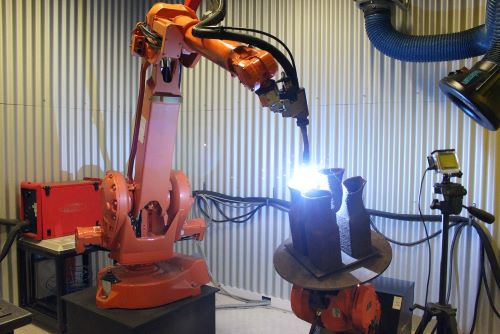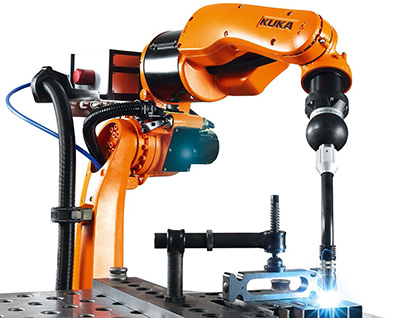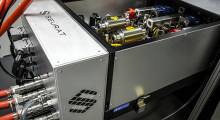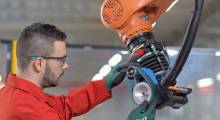Automation anxiety is an undercurrent of modern labor. Will a robot take over and run me right out of a job? When it comes to metalworking, robotics is supplementing labor without displacing it. In fact, highly skilled workers can supervise robots that are safe, fast, and efficient.
The U.S. will have a shortage of 400,000 welders by 2024, predicts the American Welding Society, as workers age out and young people are reluctant to enter the profession.
When manufacturers add advanced robotics to human workers, they can benefit from increased productivity, quality, and the ability for employees to focus on other value-added tasks.
Retraining skilled workers
KUKA AG recently opened a training center in Ireleand to clarify the path ahead for skilled operators. The company is providing the Irish Louth & Meath Education and Training Board with multiple robots for the new Advanced Manufacturing Training Centre of Excellence (AMTCE), touted as “the largest vocational training facility of its kind in Europe.”
According to KUKA, the training facility will be well-stocked with robots, including customized six-axis industrial robots with vision systems, robot welding cells, robot milling/machining cells, and collaborative robot cells.
The center will be the site of new training courses designed to retrain operators and technicians. This comes at a time when industrial manufacturing and metal cutting is undergoing an automation renaissance with greater implementation of Industry 4.0. It's also part of the Irish government's COVID-19 reconstruction plan.
New possibilities with additive manufacturing
When it comes to arc welding with robots, scientists and engineers are developing technogies that promise to improve production. 3D printing is no longer just for prototyping and has made its debut in the aerospace manufacturing and construction industries. Suppose we combined arc welding with additive manufacturing? It’s already happening around the globe.
Doctoral students at University of Waikato in Hamilton, New Zealand, are working on the production of heavy parts using additive manufacturing and robotic welding.
TiDA Ltd. is working with the researchers to use wire arc additive manufacturing, or WAAM, to repair, remanufacture, and fabricate large metal components in almost any shape. 3D metal printing has made great strides globally in recent years, allowing heavy parts made from metallic feedstocks to be created from digital scans and following the rules and commands of a programmed application.
Using complex software, the New Zealand team developed software to enable a robotic arc welder to serve as the “printer.” The researchers said they see it as a boon to self-sufficiency in the supply chain for things like heavy parts. This a particular concern because trade conflicts and the COVID-19 pandemic have disrupted the global supply chains for things like large metallic parts required for heavy macheriny in power plants, process plants, and other large-scale industrial facilities.
Instead of transporting the finished goods, the team merely transferred a digital file that can run on the software they created to produce a part with local materials.
It's still in its infancy, but this process demonstrates how an audacious vision and smart technologies can create useful things, especially when manufacturers are struggling to keep up with demand.

Automotive sector leads a bright future for welding robots
The global market for arc welding robots alone is about $5 billion today and could surpass $8 billion by 2027, according to Fortune Business Insights. The research firm asserted that growth in robotic welding technology is in lockstep with the “technological advancements in automation technology.”
Welding robots can cut down process time. This is due in part to devices that automate processes such as nozzle cleaning, wire cutting, and other tasks to speed up the overall process. Robots can also create a safer and streamlined environment on the production floor for human workers.
Fortune Business Insights added that arc welding is expected to lead the pack in robotic welding applications, with the most demand realized from the automotive sector. It also said the Asia-Pacific region is expected to create the greatest demand.
While automotive manufacturers have long used robots for metalworking, automated welding is still in the early adoption phase. Workers will need to be retrained, and the industry will need to be educated to scale use. However, the combination of improving technologies in robotic welding and additive manufacturing could result in brand-new processes and products.
About the Author
Follow Robotics 24/7 on Linkedin
Article topics
Email Sign Up
















